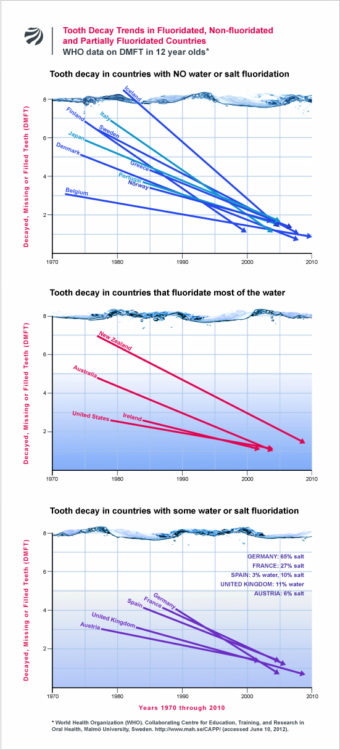From an article on David Wolfe.com:
Water fluoridation has been around since 1951 and today affects the tap water supply for two-thirds the population of the U.S.
And that is not the only means through which we are exposed to fluoride; bottled water manufacturers in the U.S. are not required to disclose how much fluoride is in their products. Further, dentists frequently force fluoride treatments on us as a standard procedure.
There’s no escaping it outside of the country either, with the practice still in effect in Canada, Australia, Brazil, Malaysia and roughly 24 other countries, exposing over 370 million people worldwide to the harmful impacts of fluoride.
But I know what you are thinking; our government puts fluoride in our water to help us avoid tooth decay, right?
Why is it, then, that levels of tooth decay have fallen at roughly equivalent rates from country to country, whether or not they fluoridate their water. This infographic from Fluoride Alert says it all:

In all reality, Fluoride is a mineral that occurs naturally in the body as well as water. The artificial addition of fluoride is not only a waste of money, costing the average taxpayer in the U.S. $1.02 per year; it exposes us to far too much fluoride, robbing us of the benefits that come from drinking pure water.
However, thanks to a new study in Pharmacognosy Magazine, you might just have a means of countering all that fluoride you are exposed to.
Curcumin, a nutrient found in turmeric that we’ve spoken about many times, can – as the study linked above mentions – prevent brain damage that is caused by fluoride.
The study was conducted by researchers at the Department of Zoology at the University College of Science in India. A decade was spent investigating just how harmful fluoride is to the brains and bodies of mammals.
The report finds that health effects of fluoride include several types of cancer as well as cardiovascular and neurological diseases.
Authors of the study report that curcumin interacts with the fluoride and can have anti-oxidizing and anti-inflammatory properties, protecting cells from “singlet oxygen, hydroxyl radical and superoxide radical damage.”
Read more HERE.

